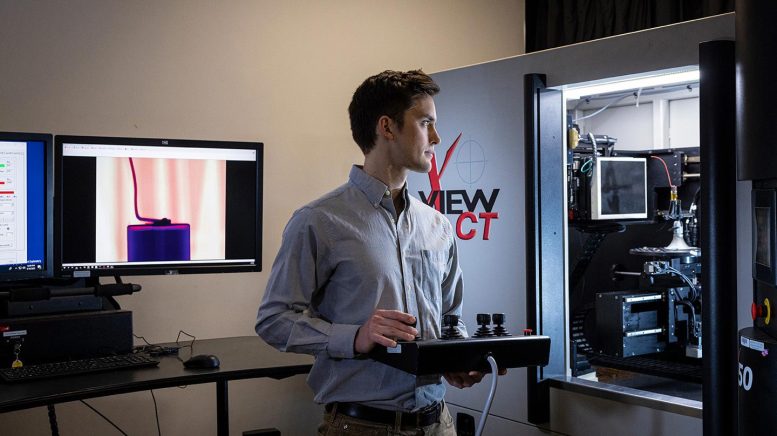
AI-driven research is making titanium 3D-printing faster, stronger, and more efficient, transforming aerospace and defense manufacturing.
Producing high-performance titanium <span class="glossaryLink" aria-describedby="tt" data-cmtooltip="
” data-gt-translate-attributes=”[{"attribute":"data-cmtooltip", "format":"html"}]” tabindex=”0″ role=”link”>alloy parts—whether for spacecraft, submarines, or medical devices—has traditionally been a slow and resource-intensive process. Even with advanced metal 3D printing, determining optimal manufacturing conditions has required extensive trial and error.
But what if these parts could be made faster, stronger, and with near-perfect precision?
A research team from the Johns Hopkins Applied Physics Laboratory (APL) and the Whiting School of Engineering is using <span class="glossaryLink" aria-describedby="tt" data-cmtooltip="
” data-gt-translate-attributes=”[{"attribute":"data-cmtooltip", "format":"html"}]” tabindex=”0″ role=”link”>artificial intelligence to turn that possibility into reality. By identifying improved processing techniques, they have enhanced both production speed and material strength—an innovation with far-reaching applications, from the ocean depths to outer space.
“The nation faces an urgent need to accelerate manufacturing to meet the demands of current and future conflicts,” said Morgan Trexler, program manager for Science of Extreme and Multifunctional Materials in APL’s Research and Exploratory Development Mission Area. “At APL, we are advancing research in laser-based additive manufacturing to rapidly develop mission-ready materials, ensuring that production keeps pace with evolving operational challenges.”
The findings, recently published in the journal Additive Manufacturing, focus on Ti-6Al-4V, a widely used titanium alloy known for its high strength and low weight. The team leveraged AI-driven models to map out previously unexplored manufacturing conditions for laser powder bed fusion, a method of 3D-printing metal. The results challenge long-held assumptions about process limits, revealing a broader processing window for producing dense, high-quality titanium with customizable mechanical properties.
The discovery provides a new way to think about materials processing, said co-author Brendan Croom.
“For years, we assumed that certain processing parameters were ‘off-limits’ for all materials because they would result in poor-quality end product,” said Croom, a senior materials scientist at APL. “But by using AI to explore the full range of possibilities, we discovered new processing regions that allow for faster printing while maintaining — or even improving — material strength and ductility, the ability to stretch or deform without breaking. Now, engineers can select the optimal processing settings based on their specific needs.”

These findings hold promise for industries that rely on high-performance titanium parts. The ability to manufacture stronger, lighter components at greater speeds could improve efficiency in shipbuilding, aviation, and medical devices. It also contributes to a broader effort to advance additive manufacturing for aerospace and defense.
Researchers at the Whiting School of Engineering, including Somnath Ghosh, are integrating AI-driven simulations to better predict how additively manufactured materials will perform in extreme environments. Ghosh co-leads one of two <span class="glossaryLink" aria-describedby="tt" data-cmtooltip="
” data-gt-translate-attributes=”[{"attribute":"data-cmtooltip", "format":"html"}]” tabindex=”0″ role=”link”>NASA Space Technology Research Institutes (STRIs), a collaboration between Johns Hopkins and Carnegie Mellon focused on developing advanced computational models to accelerate material qualification and certification. The goal is to reduce the time required to design, test, and validate new materials for space applications — a challenge that closely aligns with APL’s efforts to refine and accelerate titanium manufacturing.
A Major Leap Forward
This breakthrough builds on years of work at APL to advance additive manufacturing. When Steve Storck, the chief scientist for manufacturing technologies in APL’s Research and Exploratory Development Department, arrived at the Laboratory in 2015, he recognized the practice had its limits.
“Back then, one of the biggest barriers to using additive manufacturing across the Department of Defense was materials availability — each design required a specific material, but robust processing conditions didn’t exist for most of them,” Storck recalled. “Titanium was one of the few that met DoD needs and had been optimized to match or exceed traditional manufacturing performance. We knew we had to expand the range of materials and refine processing parameters to fully unlock additive manufacturing’s potential.”
APL spent years refining additive manufacturing, focusing on defect control and material performance. In 2021, the APL team published a study in the Johns Hopkins APL Technical Digest examining how defects impact mechanical properties. Around the same time, Storck’s team was developing a rapid material optimization framework, an effort that led to a patent filed in 2020.
This framework — designed to significantly accelerate the optimization of processing conditions — provided a strong foundation for the latest study. Building on that groundwork, the team leveraged <span class="glossaryLink" aria-describedby="tt" data-cmtooltip="
” data-gt-translate-attributes=”[{"attribute":"data-cmtooltip", "format":"html"}]” tabindex=”0″ role=”link”>machine learning to explore an unprecedented range of processing parameters, something that would have been impractical with traditional trial-and-error methods.
The approach revealed a high-density processing regime previously dismissed due to concerns about material instability. With targeted adjustments, the team unlocked new ways to process Ti-6Al-4V, long optimized for laser powder bed fusion.
“We’re not just making incremental improvements,” Storck said. “We’re finding entirely new ways to process these materials, unlocking capabilities that weren’t previously considered. In a short amount of time, we discovered processing conditions that pushed performance beyond what was thought possible.”
AI Finds the Hidden Patterns
Titanium’s properties, like those of all materials, can be affected by the way the material is processed. Laser power, scan speed, and spacing between laser tracks determine how the material solidifies — whether it becomes strong and flexible or brittle and flawed. Traditionally, finding the right combination required slow trial-and-error testing.
Instead of manually adjusting settings and waiting for results, the team trained AI models using Bayesian optimization, a machine learning technique that predicts the most promising next experiment based on prior data. By analyzing early test results and refining its predictions with each iteration, AI rapidly homed in on the best processing conditions — allowing researchers to explore thousands of configurations virtually before testing a handful of them in the lab.
This approach allowed the team to quickly identify previously unused settings — some of which had been dismissed in traditional manufacturing — that could produce stronger, denser titanium. The results overturned long-held assumptions about which laser parameters yield the best material properties.
“This isn’t just about manufacturing parts more quickly,” Croom said. “It’s about striking the right balance among strength, flexibility, and efficiency. AI is helping us explore processing regions we wouldn’t have considered on our own.”
Storck emphasized that the approach goes beyond improving titanium printing — it customizes materials for specific needs. “Manufacturers often look for one-size-fits-all settings, but our sponsors need precision,” he said. “Whether it’s for a submarine in the Arctic or a flight component under extreme conditions, this technique lets us optimize for those unique challenges while maintaining the highest performance.”
Croom added that expanding the machine learning model to predict even more complex material behaviors is another key goal. The team’s early work looked at density, strength and ductility, and Croom said it has eyes on modeling other important factors, like fatigue resistance or corrosion.
“This work has been a clear demonstration of the power of AI, high-throughput testing, and data-driven manufacturing,” he said. “It used to take years of experimentation to understand how a new material would respond in our sponsor’s relevant environments, but what if we could instead learn all of that in weeks and use that insight to rapidly manufacture enhanced alloys?”
New Possibilities
The success of this research opens the door to even broader applications. The recently published paper focused on titanium, but the same AI-driven approach has been applied to other metals and manufacturing techniques, including alloys specifically developed to take advantage of additive manufacturing, Storck said.
One area of future exploration is so-called in situ monitoring — the ability to track and adjust the manufacturing process in real-time. Storck described a vision where state-of-the-art metal additive manufacturing could be as seamless as 3D printing at home: “We envision a paradigm shift where future additive manufacturing systems can adjust as they print, ensuring perfect quality without the need for extensive post-processing and that parts can be born qualified.”
Reference: “Machine learning enabled discovery of new L-PBF processing domains for Ti-6Al-4V” by Timothy Montalbano, Salahudin Nimer, Mary Daffron, Brendan Croom, Somnath Ghosh and Steven Storck, 30 December 2024, Additive Manufacturing.
DOI: 10.1016/j.addma.2024.104632
